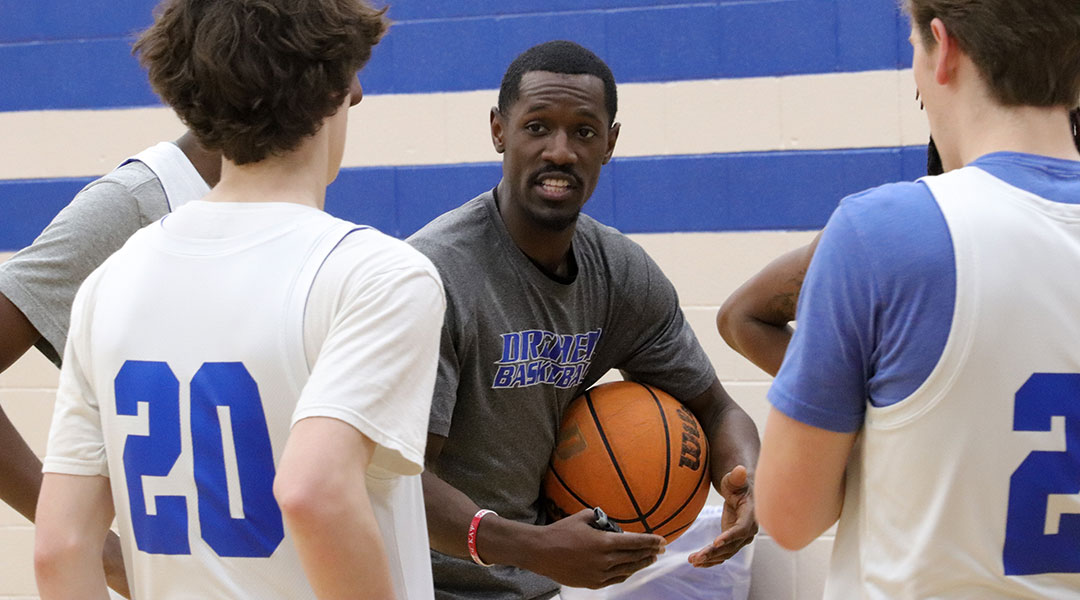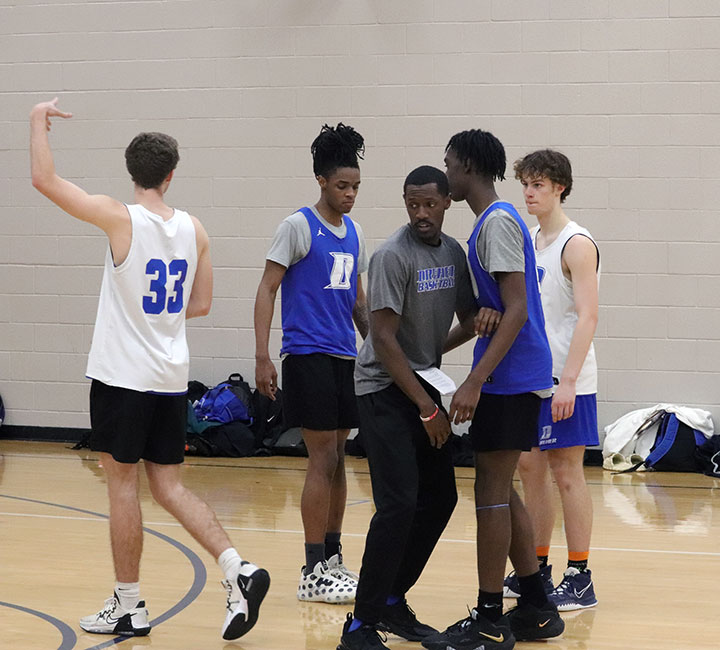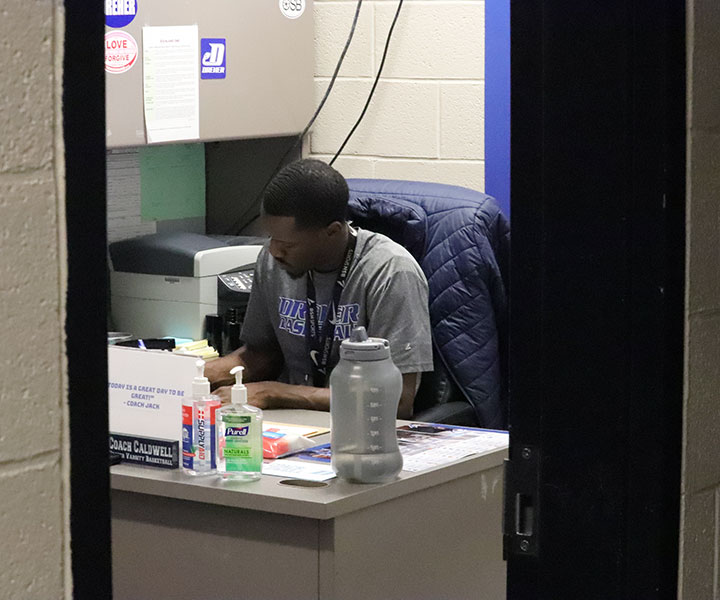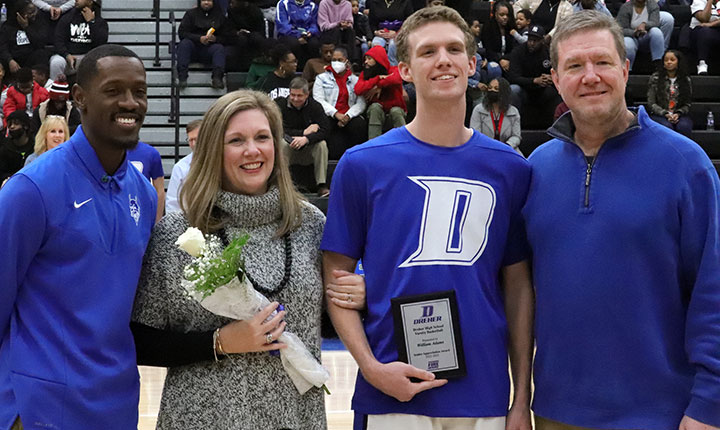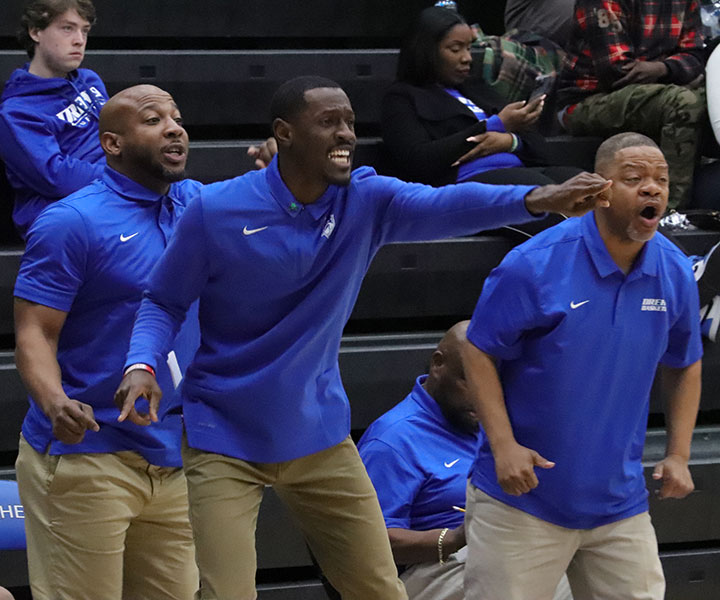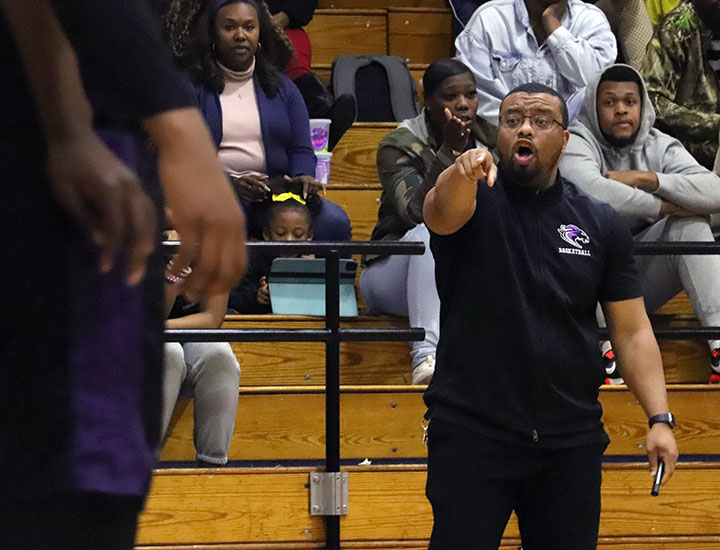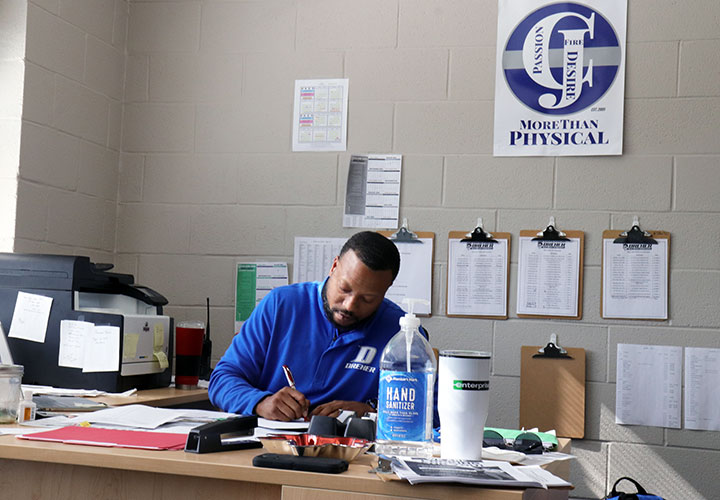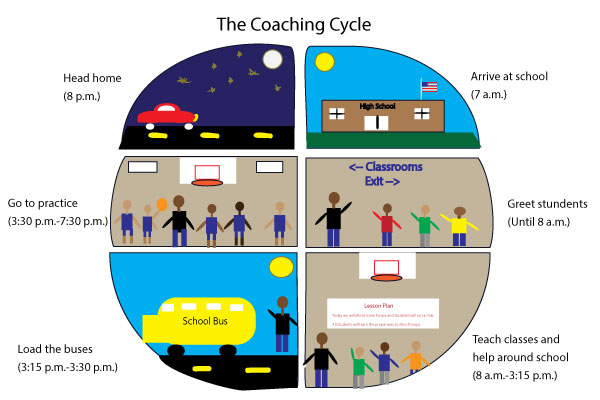Dreher boys’ basketball coach Adolph “AJ” Caldwell addressing his players during practice. Dreher as of Feb. 10 was 4-4 in region play with one regular-season game left. (Photos by Jacob Phillips)
Adolph Caldwell makes the roughly 30-minute drive from his home in Cayce to Dreher High School every day, arriving around 7 a.m.
Caldwell, who is Dreher’s boys head basketball coach, gets up at 6 a.m. When his team holds morning weightlifting workouts, he is forced to wake up even earlier.
Why is he willing to get in his car so early? For the love of the sport, in part. But he’s also heavily invested in his players and is more than a coach to them.
That’s why, when things in practice get intense, Caldwell’s players know it’s not personal. It’s all just to make the team better.
“He expects a lot of us,” said senior Ryan Lominack.
High school coaches in South Carolina balance numerous responsibilities, forcing them to work long days that sometimes don’t end until after 8 p.m. Coaches are also teachers, athletic directors, guidance counselors and community volunteers who often play an outsized role in students’ lives.
“We have a lot of hats,” Caldwell said.
And there are a lot of these coaches.
In 2021, the South Carolina Athletic Coaches Association reported 6,928 active members across the state. Many of these coaches, like Caldwell, balance numerous roles day to day.
Rise and grind
Caldwell’s first job starts at his post greeting students as they start their day.
The time in the hallway gives Caldwell the chance to interact and connect with all types of students, not just his basketball players. Many coaches have said connecting to non-athletes is an important part of their job.
“They realize how the athletic kids talk with us, and laugh with us, and play with us, and then I’m talking to kids in this hallway that I won’t see after the (day’s final) bell rings,” said Dreher Head Football Coach Corey Jenkins. “They get on the bus and go home. But they’ll come into school the next day, and they’ll be like, ‘Hey, Coach Jarvis. Hey, Coach Jenkins. Hey, Coach Caldwell.’”
Once the first-period bell rings, Caldwell begins his second job of the day, teaching P.E. classes.
“I think the best part is coming into a gym every morning and knowing that this is your classroom,” Caldwell said.
Teaching is a big part of a high school coach’s job. Caldwell said before deciding to become a high school basketball coach, a person needs to determine what subject he or she would like to teach.
“It’s going to be difficult to come in and just say, ‘Oh, I just want to coach,’” he said. “It don’t work like that. Once you’re certified, then I feel like the sports will take care of itself.”
Caldwell teaches three classes on alternate days. He has his P.E. classes for first, second and third periods. Then, he has his planning period, giving him time to work on his many other responsibilities.
Filling the gaps
There are plenty of other things around the school that Caldwell and Jenkins do when they’re not teaching.
They can be found working lunch duty, helping run the school canteen, clearing the hallways and, for some, fulfilling their duties as assistant athletic directors.
Coaches sometimes also help maintain buildings on their campuses. For example, if a storm hits, coaches are among the faculty members responsible for making sure the building is safe after the storm passes. They also often are the ones who turn on the lights in the mornings and open the doors for everyone else.
Motivating students to keep up their grades is another big part of a coach’s job.
“I truly believe we coach 20% of the day,” said Jenkins, the football coach. “And the other 80% … you are trying to raise these young men and women.”
The fourth-period bell rings at 3:15 p.m., letting students out of classes for the day. But for Caldwell and Jenkins, the end of the school day is not the end of the day for them. It’s just the end of Part One.
Caldwell and Jenkins help with clearing the students from the school and monitoring the buses to make sure all students get where they need to be.
They will then get ready for Part Two. That’s when Caldwell’s job, for example, shifts from being a classroom educator to being a coach.
Daily court appointment
Basketball practice at Dreher starts at 3:30 p.m.
Some days, the varsity and junior varsity boys’ basketball teams have joint practices, that can run from until 5:30 p.m.
On other days, the teams hold separate practices, which keeps Caldwell at Dreher even longer.
The varsity team attends weight-room and film-study sessions when there are separate practices. Then the team gets in the gym around 5:30 p.m.
Caldwell and his group of assistants will run the team through drills and go over offensive and defensive sets to prepare for that week’s games.
Coaches have said having a strong team of assistants helps reduce some of the work a high school coach faces.
“I have really, really, good assistant coaches,” said Ridge View Boys’ Basketball Head Coach Joshua Staley. “They make it easy for me.”
Caldwell’s group treats each other like brothers. The bond they share has rubbed off on the team, making the whole group feel like a family.
“They treat us like their kids at the end of the day,” senior Carroll Kelley said. “I came from a different school and (Caldwell) welcomed me with open arms. He showed me what I wanted to see. He was intense with us. He pushes us day and night. But we all love him.”
When practice wraps up, Caldwell calls the team to center court to review their weekly strategy.
“After 7:30, we put the jerseys in the washer and we put everything back,” Caldwell said. “You might have a few of them that want to stick around and get some free throws or to get some extra shots in. So instead of me leaving here at 8 p.m., I might not leave until 8:30 p.m.”
Finally, finishing the day
Caldwell’s day still isn’t over.
It’s up to him to make sure the gym is cleared of gear and everything is back in place for the next day. More importantly, he never leaves until every single student has gotten his ride home.
“We have to stay around … no matter if it’s a cheerleader, a basketball player, football player,” Caldwell said. “Whether it’s for an hour or three minutes, we have to make sure that we stay and wait until all the kids are off campus.”
Caldwell usually leaves school around 8 p.m., making for a long 12-hour workday. It’s not uncommon. Game days keep coaches around even later, often until well after 10 p.m.
On this practice night, Caldwell finally arrives home around 8:30 p.m., just in time to eat and talk to his significant other about his day.
“One thing that’s really good is being in a relationship,” Caldwell said. “That keeps me really sane. … And it keeps me stress-free because I have a girlfriend that has really adapted to my life.”
The next morning, he gets up and does it all over again.
They coach for the kids
The long workdays don’t discourage Caldwell or other coaches from doing their best.
It comes with the job. The opportunity to stay around the sport they love, while molding the next generation, makes it all worth it for many coaches.
“Obviously basketball was a passion, but also developing relationships and helping young people move forward” is why Ridge View’s Staley said he loves the work.
It’s also why Caldwell got into coaching. He wants to affect his players and students. But it is often the most difficult part of his job.
“Every kid can’t be coached the same,” he said. “So we’re learning that the same way you coach this kid, you can’t coach another kid. And that’s just a challenge, day in and day out.”
The time Caldwell invests in his players makes it a little easier to figure out all of their different personalities. They form a bond.
“He works with me a lot more,” said junior Jordan Barr, who’s new to the team. “More than any other coach.”
He knows “how to ‘get’ somebody,” Barr said.
There are rare occasions at school when an athlete faces discipline, or an athlete has to have a parent conference. Caldwell usually is involved in those meetings.
That is why being on-site during school hours is important for a high school coach.
“I want you to be in the building, whether you teach or not teach – instructional assistant, security, something,” said Dreher Athletic Director Daryl Jarvis. “I want you to build and be able to see your kids on a daily basis.”
The work doesn’t stop in the summertime, either.
“If you want to compete at a high level, coaching has to be year-round,” Staley said. “It’s different phases at different levels, but you always have to work on things.”
The biggest “thing” is the student, of course.
“I look at coaches like parents almost, because it does take a village to raise certain children,” Caldwell said. “Everything is going to hit them really fast, whether they’re in the workforce, in the army. It’s going to hit them really fast, and if high school coaches aren’t preparing them for it, they will probably fall flat on their faces.”
Caldwell instructs his players during drills and often jumps in to demonstrate.
When not in the gym, Caldwell often works at his desk in his office on numerous basketball and non-basketball activities.
Caldwell with senior Preston Adams and family on Dreher’s Senior Night. Adams spent the past two seasons playing on the varsity basketball team for Caldwell.
Caldwell prepares the rim for a team rebounding and box-out drill.
Caldwell and varsity Assistant Coaches Dre Dantzler, left, and Pete Faust, right, attempt to get the team’s attention during a tight game against Orangeburg-Wilkinson High School.
Ridge View basketball coach Joshua Staley is in his first season at the helm of the Blazer program after leaving his previous job as the head coach of AC Flora High School.
Dreher Athletic Director Daryl Jarvis made the transition to an athletic administration position after a successful multi-sport coaching career.

